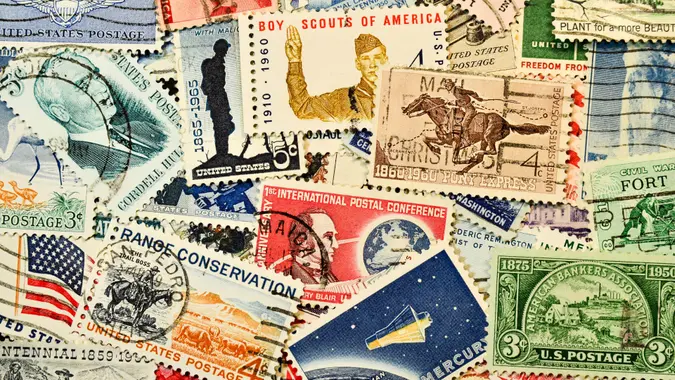7 Popular Collectibles That Have Plummeted in Value

Commitment to Our Readers
GOBankingRates' editorial team is committed to bringing you unbiased reviews and information. We use data-driven methodologies to evaluate financial products and services - our reviews and ratings are not influenced by advertisers. You can read more about our editorial guidelines and our products and services review methodology.

20 Years
Helping You Live Richer

Reviewed
by Experts

Trusted by
Millions of Readers
The collectibles market, which saw a surge during the pandemic when people had more time and money to dedicate to hobbies, is showing signs of cooling.
This leveling off of interest is particularly true of items manufactured in the last half of the 20th century. Why? Consider it a changing of the guard.
According to Shawn Surmic, a collectibles expert and founder of and host of Reserved Investments, many items beloved by baby boomer collectors are falling out of favor.
“Now that boomers are retiring, many of those items that were popular with them aren’t being bought up by younger generations,” he said. “PEZ dispensers, slot cars… Gen X and Millennials just aren’t into that stuff.”
Those aren’t the only items dropping in value. Below is a list of collectibles that are showing signs of marked depreciation.
Stamps
Collectible stamps have been in decline for several years now. The category, said Surmic, has seen a double-digit decline in value in the U.S. year-over-year.
“They are nowhere near the heavyweight they once were,” he said. “The market is dying out, and it’s due to the fact younger generations haven’t taken an interest in stamps like they have coins and currency, which they still use on a regular basis.”
Beatles and Elvis Memorabilia
While personal items that belonged to Elvis or John Lennon will still do well at auction, Surmic said mass-produced Beatles and Elvis memorabilia generally won’t.
Again, he said it’s because a lot of younger generations don’t have the same personal connection to bands from the ’50s and ’60s that their parents or grandparents had.
20th Century Figurines
Dolls, figurines, Hummels — all of these are “dead categories,” according to appraiser and collector Gary Sohmers, who is also a regular on PBS’ “Antiques Roadshow.”
Some of the decline in value for these items Sohmers attributes to the laws of supply and demand.
“Pre-internet, no one knew how many of these items were made, since ‘limited’ just meant limited to how many a manufacturer could make within a time period,” he said. “There is zero demand for most of these items now.”
Holiday Barbie Dolls
By that same logic, holiday-edition Barbie dolls, even those still in their original packaging, have also declined in price.
“Barbies were mass-produced in the heady days of the later 20th and 21st century, when there was a preconceived notion that all collectibles and numbers edition items would automatically rise in value,” said Nora Curl, founder of Appraise Antiques and a JustAnswer appraisals expert.
A notion, she said, that hasn’t born out.
Victorian-Era Furniture
In the ’90s, large, vampiric furniture from the Victorian era was all the rage — with many collectors valuing its gothic vibe. But that hasn’t held since the heyday of “Mad Men” and “Downton Abbey” — both shows that ushered in a trend for mid-century modern decor.
Surmic pointed out that pop culture is partially to blame for the decline in Victorian furnishings, though said there were other reasons a more modern aesthetic has taken hold of late.
“Honestly, what’s driving the demand for mid-century modern is just the fact that young collectors, especially millennials, like lightweight furniture,” he said.
Vintage Lunch Boxes
Like PEZ dispensers, and a lot of other nostalgic memorabilia from the mid-20th century, vintage lunch boxes don’t have the same mass appeal as they once did. Sohmers attributed this to what he termed “a nostalgia curve.”
“When collectors reach 33 and become more settled into a lifestyle, they find the extra income and returned desire for objects from their youth, and that drives demand,” he said. “But when collectors reach 60-plus, they often de-assess their collections, lose interest or die.”
As a result, he said, the “curve” for items from the ’50s and ’60s has sharply declined.
Vintage Advertising
In the previous decade, Surmic said there was a surge in interest in vintage advertising — think neon Coca-Cola signs.
This was in part due to the popularity of the show “American Pickers,” which premiered on the History Channel in 2010. The show created a bubble for salvaged Americana that hasn’t carried over into the present.
“People got too carried away and were paying crazy prices for that stuff. Now, the market’s gone soft,” he said. “A lot of younger collectors just don’t identify with a vintage John Deer or Mobile-Exxon sign.”
More From GOBankingRates
 Written by
Written by  Edited by
Edited by 

























